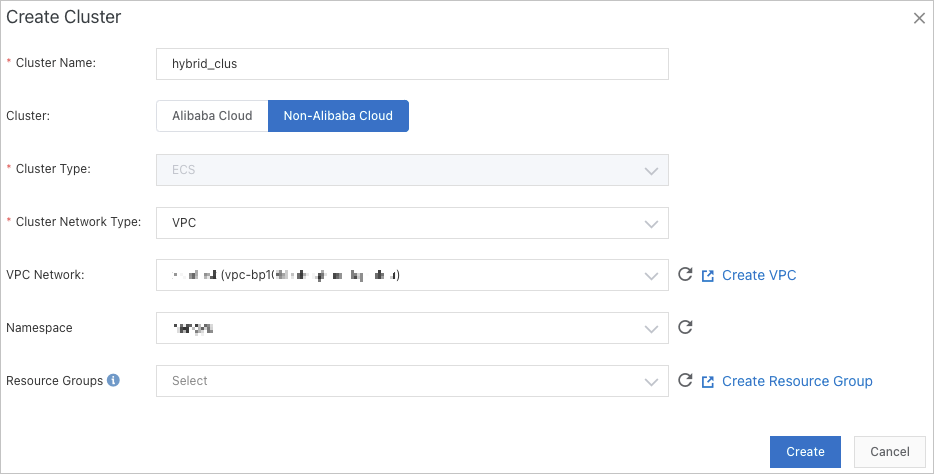Enterprise Distributed Application Service (EDAS) allows you to deploy applications in hybrid cloud Elastic Compute Service (ECS) clusters and provides complete solutions for scale-out, networking, and centralized management in these clusters. You can connect Alibaba Cloud ECS instances, servers from data centers, and servers from other cloud service providers by using Express Connect circuits, and add the instances and servers to hybrid cloud ECS clusters in EDAS. This way, you can deploy applications in these clusters and use application management capabilities that are provided by EDAS.
Prerequisites
Background information
Your application system may have the following requirements and problems:
- The traffic on Alibaba Cloud has a specific degree of volatility and you may face traffic spikes in special scenarios. You can predict the traffic volumes in these periods. However, the prediction result may not be accurate. The time for scale-outs and the number of ECS instances are difficult to determine. You must purchase ECS instances in advance.
- Some core business systems have high security requirements and you want to deploy relevant applications in your data center. However, you cannot centrally manage applications that are deployed in different environments because Alibaba Cloud ECS instances, servers from data centers, and servers from other cloud service providers cannot communicate with each other.
- Based on your business needs and availability requirements, you want to deploy your applications in a hybrid cloud environment. However, you cannot centrally manage these applications. Manual processing is required and misoperations may occur.
Hybrid cloud clusters can meet these requirements and solve these problems.
The following figure shows the architecture of a hybrid cloud ECS cluster.

- A hybrid cloud cluster contains Alibaba Cloud ECS instances, servers from data centers, and servers from other cloud service providers.
- Alibaba Cloud ECS instances, servers from data centers, and servers from other CSPs are connected by using Express Connect circuits.
- Applications can be deployed in hybrid cloud ECS clusters.
In the hybrid cloud environment, EDAS is used in the following scenarios:
- Manage applications in data centers by using EDAS on Alibaba Cloud: After you connect your data center to a virtual private cloud (VPC) of Alibaba Cloud by using an Express Connect circuit, you can manage the applications in your data center by using EDAS on Alibaba Cloud.
- Deploy and manage servers from other cloud service providers: EDAS allows you to deploy applications to servers from cloud service providers other than Alibaba Cloud and manage these servers in a centralized manner.
This topic describes how to manage servers from data centers by using EDAS on Alibaba Cloud. To manage servers from other cloud service providers, you need only to connect the servers to a VPC of Alibaba Cloud in EDAS by using Express Connect circuits. Then, you can manage these servers in the same way as you manage servers from the data centers that are connected to Alibaba Cloud.
Preparations
- Create an IPv4 VPC.
- Activate Express Connect. For more information, see Express Connect.
- Apply for a dedicated connection over Express Connect to connect your data center to a VPC of Alibaba Cloud. For more information, see Create a dedicated connection over an Express Connect circuit.
-
Make sure the servers in your data center meet the following requirements:
- Operating system: CentOS 7.
- Form: physical or virtual machines. Docker containers are not supported.
- Hardware: no special requirements for CPU and memory.
Step 1: Create a hybrid cloud cluster
Step 2: Add instances to the hybrid cloud cluster
You must add ECS instances, servers from your data center, and servers from other cloud service providers to the newly created empty hybrid cloud cluster.
Step 3: Enable required ports
To ensure that related capabilities provided by EDAS are available for your applications in the hybrid cloud cluster, you must enable the following ports for the instances after you add them to the cluster:
- 8182: this port that is used to capture basic monitoring and trace monitoring logs.
- 12200 to 12300: the ports that are used to complete remote procedure calls (RPCs).
- 65000 to 65535: the web ports.
The methods of enabling ports vary based on the instance types in the cluster.
- ECS instances: For more information about how to enable the ports, see Add security group rules.
- Servers from data centers or other cloud service providers: For more information about how to enable the ports, see the corresponding solutions.
Verify the result
What to do next
After a hybrid cloud ECS cluster is created, you can deploy applications in the cluster. The method of deploying applications in a hybrid cloud ECS cluster is the same as that in an ECS cluster. For more information, see Overview.
